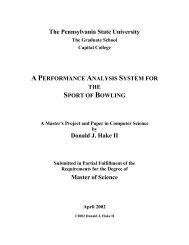Heuristic Methods for Graph Coloring Problems
Heuristic Methods for Graph Coloring Problems
Heuristic Methods for Graph Coloring Problems
Create successful ePaper yourself
Turn your PDF publications into a flip-book with our unique Google optimized e-Paper software.
Parameters Pure <strong>Coloring</strong> Bandwidth <strong>Coloring</strong> MCP Bandwidth MCP<br />
Restarts No. 10 10 10 10<br />
SWO Iteration 200 400 400 400<br />
Blame Rate α 0.95 0.95 0.95 0.95<br />
Blame Value b 4 4 4 8<br />
TS Iteration 100 100 200 200<br />
No. of TS Moves 40 40 50 50<br />
TS Tenure 5 5 5 5<br />
1 Not presented in [15]<br />
Table 1: Parameter Settings<br />
Pure <strong>Coloring</strong> Bandwidth <strong>Coloring</strong> MCP Bandwidth MCP<br />
M1 M2 M1 M2 M1 1 M2 M1 2 M2<br />
Wins 0 0 0 17 - 0 16 22<br />
Ties 30 31 15 14 - 33 1 11<br />
Loses 3 2 18 2 - 0 0 0<br />
Max Wins 0 0 0 5 - 0 77 11<br />
Avg. Wins 0 0 0 1.53 - 0 20.75 5.23<br />
Max Loses 1 1 11 2 - 0 0 0<br />
Avg. Loses 1.00 1.00 4.61 1.50 - 0 0 0<br />
2 Only 17 instances presented in [15]<br />
Table 2: Comparison of M3 with M1 and M2<br />
width <strong>Coloring</strong> are not presented here due to the space limitation),<br />
where k denotes the number of colors and t denotes<br />
the running time in seconds. In [15], when there are no<br />
results <strong>for</strong> the MCP, and only partial results <strong>for</strong> the Bandwidth<br />
MCP, we write “-” in the tables to denote this.<br />
The per<strong>for</strong>mance of the algorithms is good in all four problems<br />
and especially so <strong>for</strong> the Bandwidth MCP. We conducted<br />
the experiments using Bandwidth MCP instances<br />
which are not covered in [15]. Results tied or surpassed all<br />
of the results in [15] and [11]. Although the methods that<br />
are applied in [15] are good <strong>for</strong> GCP and per<strong>for</strong>m well on<br />
the DIMACS geometric graph instances, the new algorithm<br />
is only weaker in 3 out of 33 cases and <strong>for</strong> only 1 color each.<br />
In the Bandwidth <strong>Coloring</strong> Problem, results are not as good<br />
as [15] although comparable with [11].<br />
We believe that the method in [15] does not work well <strong>for</strong><br />
the Bandwidth MCP because there are too many variables<br />
and constraints to check simultaneously. The backtracker<br />
used there would take a long time to deal with the many<br />
constraints. However, the approach given in [11] and here<br />
always generates a solution quickly and then improves on it<br />
incrementally. One of the reasons why the method outper<strong>for</strong>ms<br />
[11] is that TS works well with SWO and is able to<br />
avoid local optima. Furthermore, we used TS after SWO,<br />
whereas hill-climbing was implemented in each iteration of<br />
the SWO in [11] which results in longer times. In the same<br />
amount of time, we were able to run more iterations of SWO<br />
to refine the solutions.<br />
It is interesting that in the MCP, we obtained the same<br />
results as [11] on all the 33 instances. No results are provided<br />
in [15] <strong>for</strong> this problem.<br />
In terms of running time, the method takes relatively<br />
longer times <strong>for</strong> small instances, especially <strong>for</strong> the <strong>Coloring</strong><br />
and Bandwidth <strong>Coloring</strong>. However, the running times<br />
did not increase sharply when instances became larger, and<br />
are comparable with the other two methods. We believe<br />
this is due to the different heuristics setup. Since we used<br />
constant parameters, running times will not change much<br />
as the sizes vary; however, the running times of the other<br />
heuristics were dependant on the instance sizes.<br />
5. CONCLUSION<br />
In this work, we discussed several variations of generalized<br />
graph coloring problems and proposed a new hybrid<br />
SWO with TS technique to solve these. Experiments are<br />
conducted using benchmark problems and results compared<br />
with those obtained by existing methods. These results show<br />
that this approach is effective <strong>for</strong> the problems studied and<br />
provides superior results than the current methods <strong>for</strong> the<br />
Bandwidth MCP.<br />
6. REFERENCES<br />
[1] D. Brelaz. New methods to color the vertices of a<br />
graph. Communications of ACM, 22(4):251–256, 1979.<br />
[2] David P. Clements, James M. Craw<strong>for</strong>d, David E.<br />
Joslin, Geoge L. Nemhauser, Markus E. Puttlitz, and<br />
Martin W.P. Savelsbergh. Heurstic optimization: A<br />
hybrid ai/or approach. In Proceedings of the Workshop<br />
on Industrial Constraint-Directed Scheduling, 1997.<br />
[3] Joseph C. Culberson and Feng Luo. Exploring the<br />
k-colorable landscape with iterative greedy. Cliques,<br />
<strong>Coloring</strong> and Satisfiability, Second DIMACS<br />
Implementation Challenge, 1993.<br />
[4] Fred Glover and Manuel Laguna. Tabu Search. Kluwer<br />
Acadamic Publishers, 1997.<br />
[5] Fred Glover, Mark Parker, and Jennifer Ryan.<br />
<strong>Coloring</strong> by tabu branch and bound. Cliques, <strong>Coloring</strong><br />
937
















